Bihari cuisine is a delectable tapestry of flavors from the Indian state of Bihar, celebrated for its rustic charm and unique culinary traditions. With a strong emphasis on locally sourced ingredients, Bihari dishes are characterized by simplicity and robust taste. Litti Chokha, a staple, features wheat balls paired with spiced mashed vegetables. Sattu, a nutritious roasted gram flour, is a key ingredient. From the indulgent flavors of litti to the comforting taste of thekua, Bihari cuisine offers a soulful journey through the heartland of India, enticing food enthusiasts with its authenticity and diverse culinary expressions.
Thekua
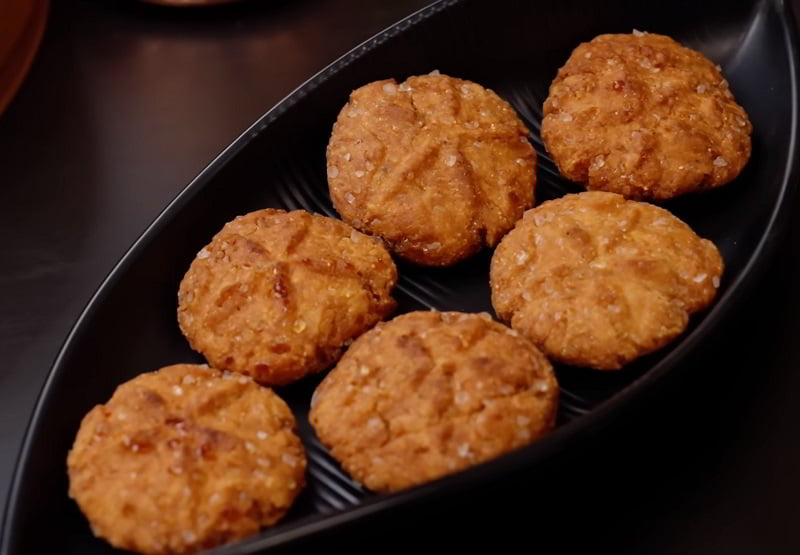
Thekua, also known as Khajuria, Tikari, and Thokni, stands as a revered Indo-Nepalese cookie deeply embedded in the culinary traditions of the Indian subcontinent. Particularly popular in the states of Bihar and Uttar Pradesh, as well as the Terai region of Nepal, Thekua holds a special significance as a prasada during Chhath puja, making it a cherished offering to the divine. This sweet snack, existing for centuries, boasts a simple yet flavorful composition with its key ingredients being chasni (melted sugar), wheat flour, and ghee. Occasionally, jaggery is used as a sweet alternative to sugar. The dough, enriched with cardamom for an enhanced taste, is meticulously crafted using a distinctive wooden cookie mold that imparts intricate designs to the thekua. The final touch involves deep-frying the dough in ghee or vegetable oil until it attains a rich reddish-brown hue. While soft when hot, the thekua transforms into a delectably firm texture upon cooling.
With no need for preservatives, this delightful treat can be stored for several days, ensuring a sweet indulgence that resonates with cultural heritage and culinary craftsmanship.
Sattu
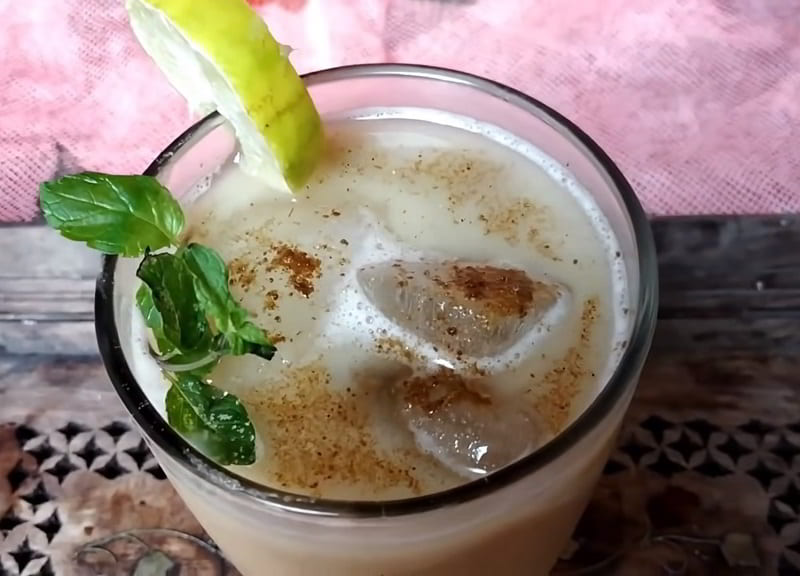
Sattu, a beloved dish in Bihari cuisine originating from Bihar, India, is crafted from roasted Bengal gram flour, commonly known as sattu flour. This flour is meticulously prepared by roasting Bengal gram and grinding it into a fine powder. To create the sattu dish, the flour is combined with water, lemon juice, and salt, forming a dough-like consistency. The mixture is then shaped into small balls or flattened discs and cooked on a tawa (griddle) until achieving a delightful golden brown and crispy texture. Sattu transcends its solid form and transforms into a refreshing summer drink by blending it with water, lemon juice, and sugar, renowned for its cooling properties. Additionally, sattu plays a pivotal role in various dishes like litti chokha, where it serves as a flavorful stuffing for roasted wheat balls.
Beyond its delectable taste, sattu stands out for its nutritional richness, boasting high protein, fiber, and essential minerals—a wholesome and healthy choice in Bihari cuisine, cherished for its simplicity and versatility.
Kachori
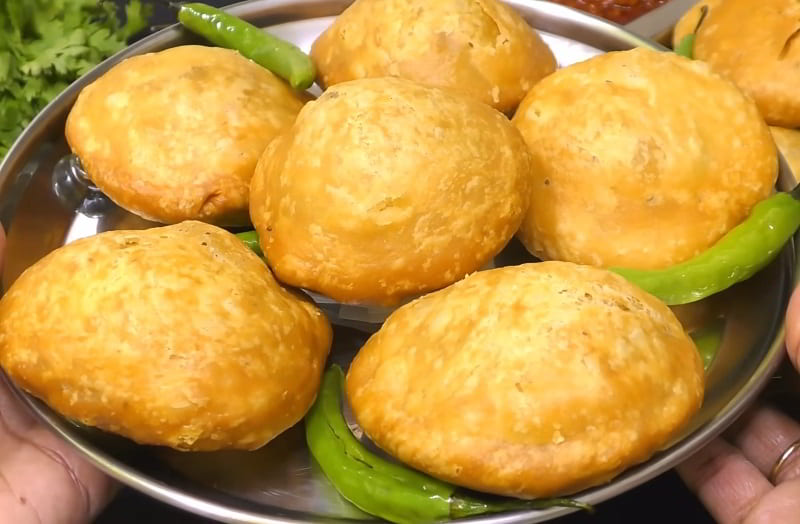
Kachori, a delectable deep-fried snack with origins rooted in India, has become a culinary delight celebrated across the globe, especially in regions with a significant South Asian diaspora. This sweet and spicy treat is crafted by enclosing a flavorful stuffing within a crispy and golden-brown, deep-fried outer layer. The dough for kachori is typically made with flour, ghee, and water, resulting in a flaky and delightful texture upon frying.
This iconic snack has given rise to various regional adaptations, each offering a unique twist to the classic recipe. Notable variations include Pyaaz Kachori, where the filling features a savory blend of onions, spices, and sometimes lentils. Kota Kachori, hailing from the city of Kota, is renowned for its spiced lentil filling. Raj Kachori, a larger and more elaborate version, often features a diverse range of toppings like yogurt, chutneys, and sev. Mawa Kachori, on the other hand, is a sweet rendition filled with a rich mixture of khoya (reduced milk), nuts, and aromatic spices.
These diverse kachori varieties showcase the culinary creativity embedded in Indian cuisine, making this snack a versatile and beloved part of cultural celebrations and everyday indulgences alike.
Khaja
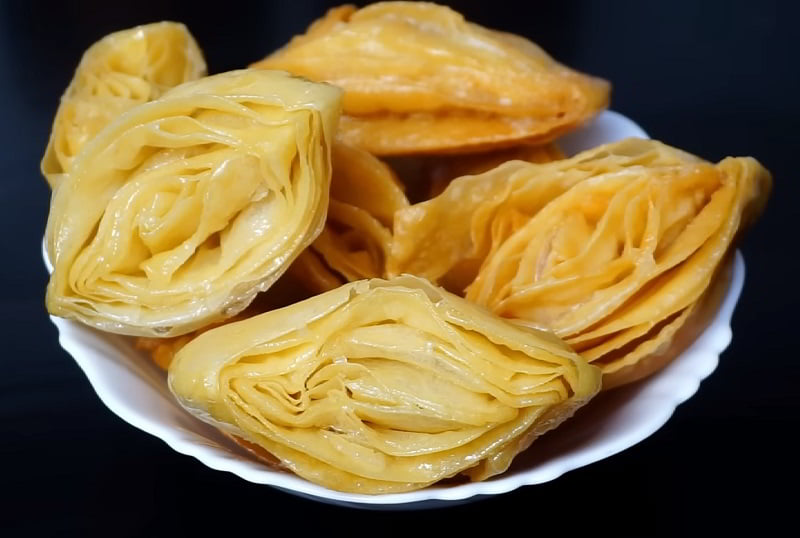
Khaja, whether enjoyed plain or sweet, is an iconic wheat flour delicacy, with its roots embedded in the cultural fabric of Magadh and the United Provinces. Hailing from the eastern regions of the former state of Magadh, specifically Silao and Nalanda districts in Bihar, Khaja has become an integral part of Magadh's culinary heritage. The preparation involves creating layered dough using refined wheat flour and sugar, occasionally featuring dry fruits or other delectable stuffings. Subsequently, these layered wonders are lightly fried in oil, resulting in the creation of Khaja—a revered sweet in Silao and a sentimental connection for Magadh residents.
Beyond its delectable taste, Khaja holds cultural significance, making appearances in various occasions such as Chhath Puja and being offered as a cherished gift during weddings in Magadh, Bihar. This sweet treat has transcended its culinary role to become an emotional symbol for the people of Magadh, reflecting the rich cultural tapestry and deep-rooted traditions of the region.
Dahi Vada
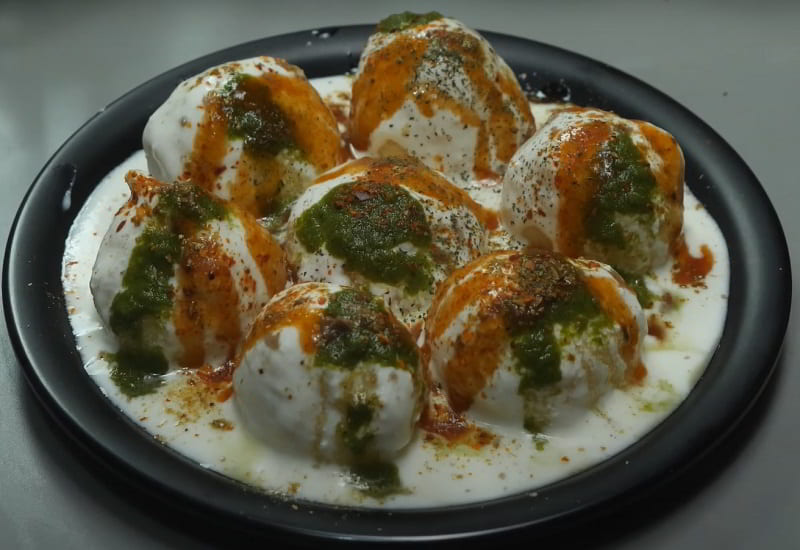
Dahi Vada, a delightful chaat originating from the Indian subcontinent, is a culinary masterpiece that captivates the taste buds. This savory snack features vadas, fried lentil balls, delicately soaked in thick dahi, or yogurt. The vadas, made from a blend of lentils, are skillfully fried to achieve a crisp texture on the outside, creating a tantalizing contrast to the soft and spongy interior. Once the vadas are fried to perfection, they are immersed in a pool of creamy and flavorful yogurt, infusing the dish with a rich and tangy taste.
The artful assembly of Dahi Vada transforms this snack into a harmonious blend of textures and flavors, making it a favorite across the subcontinent. To enhance the sensory experience, the dish is often garnished with an array of spices such as cumin, chili powder, and chaat masala, offering a symphony of tastes that elevate Dahi Vada to a cherished culinary classic.
Baingan Bharta

Baingan Bharta, a culinary gem in Indian cuisine, is a dish that celebrates the smoky allure of grilled eggplant (baigan), masterfully combined with a medley of spices and aromatics. The process begins with charring the eggplant over charcoal or direct fire, imparting a distinctive smokiness that elevates the dish. Once the eggplant is perfectly grilled, it undergoes a transformation into a luscious mash. This smoky, mashed eggplant becomes the canvas for a flavorful symphony, with browned onions, chopped tomatoes, ginger, cumin, garlic, chili pepper, and fresh cilantro taking center stage. The ensemble is harmonized with mustard oil or a neutral vegetable oil, infusing each bite with a rich tapestry of tastes.
Baingan Bharta shines as a versatile dish, finding companionship with flatbreads like roti or paratha. Additionally, it graciously shares the plate with rice or raita, a yogurt salad. The beauty of Baingan Bharta lies not just in its savory complexity but also in its ability to bring people together, creating a shared experience around the table.
Makhan Bada (Balushahi)
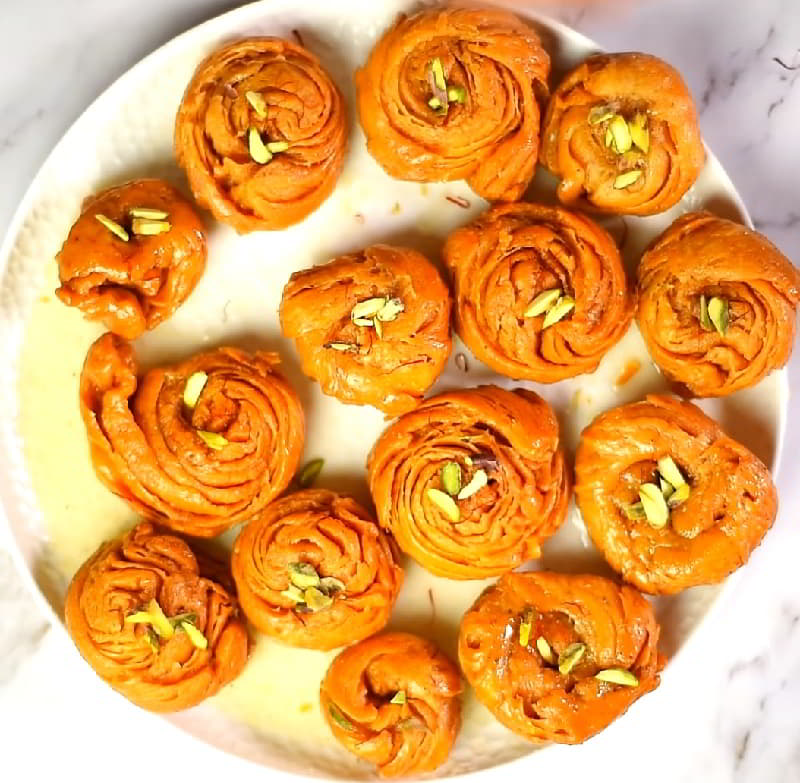
Makhan Bada, a cherished dessert hailing from the Indian subcontinent, is also fondly known as Balusaahi. This delectable treat, akin to a glazed doughnut in ingredients, stands out with its unique texture and flavor profile. While it shares some similarities with Rajasthani Baati in size and preparation, its distinctive shape is reminiscent of South Indian Medu Vada.
Crafted from maida flour, Makhan Badas undergo a delightful transformation as they are deep-fried to golden perfection in clarified butter. What sets them apart is the indulgent bath in sugar syrup, infusing each bite with a sweet and syrupy essence.
Makhan Bada is more than just a dessert; it's a culinary celebration that transcends regional boundaries. Whether enjoyed on festive occasions or as a sweet indulgence, this delightful treat brings a touch of sweetness to the diverse tapestry of Indian sweets.
Anarsa
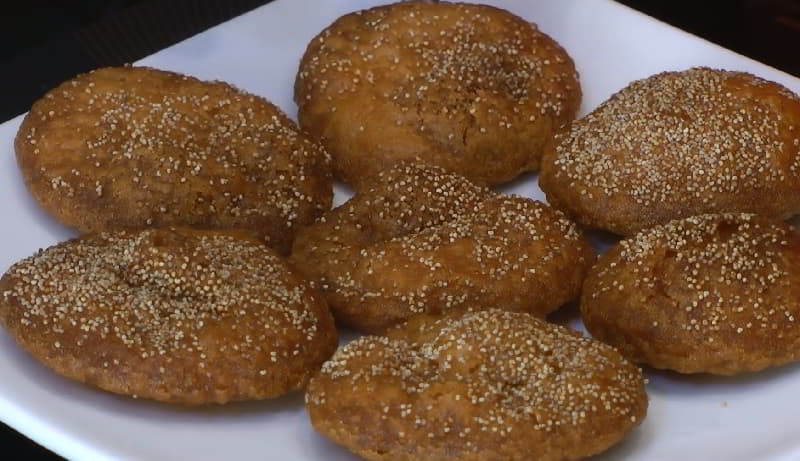
Anarsa, a sweet emblem of Bihari cuisine, graces festive tables and special occasions with its unique blend of flavors and textures. Crafted from a harmonious marriage of rice flour and powdered jaggery, the dough is expertly shaped into small discs or balls and then deep-fried to a golden brown perfection. The crowning glory of Anarsa lies in its distinctive touch—poppy seeds, which are generously sprinkled atop, introducing a delightful nuttiness and a satisfying crunch. Elevating it beyond a mere sweet, the fried Anarsa receives a sweet and crunchy coating of powdered sugar, culminating in a symphony of flavors.
This traditional delicacy not only caters to the sweet tooth but holds auspicious significance, often served as prasad during revered festivals like Diwali and Chhath Puja. Anarsa stands as a testament to Bihar's rich culinary heritage, winning the hearts of all who savor its irresistible charm.
Luchi
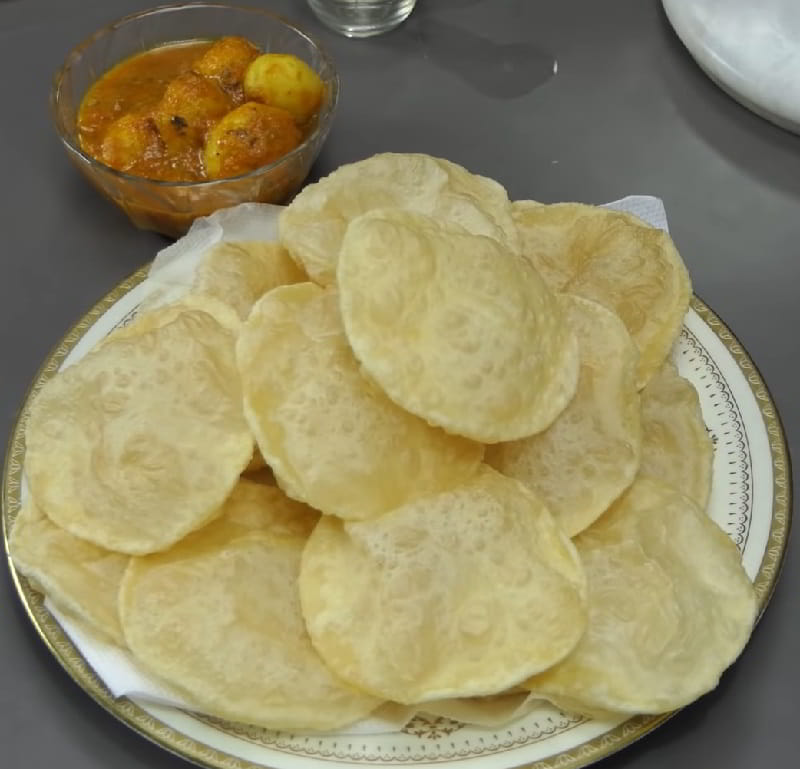
Luchi, a beloved deep-fried flatbread, takes center stage in the culinary traditions of several Indian states, including Bihar, Madhya Pradesh, Odisha, Uttar Pradesh, Assam, West Bengal, and Tripura, as well as neighboring Bangladesh. Crafted from Maida flour, luchi stands out as a versatile delicacy, finding its place on diverse occasions.
This delightful flatbread holds cultural significance, especially during rituals like ekadashi, where rice is to be avoided. Luchi, being rice-free, becomes a preferred choice and is often paired with vegetarian delights such as dum aloo. On occasions without dietary restrictions, the classic combination of luchi with kosha mangsho, a flavorful meat dish, takes center stage.
For breakfast or as a popular street food, luchi finds itself paired with Ghugni, creating a satisfying and wholesome meal. With its crisp exterior and soft interior, luchi transcends regional boundaries to become a cherished part of India's culinary tapestry, bringing joy and flavor to tables across the subcontinent.
Champaran Meat
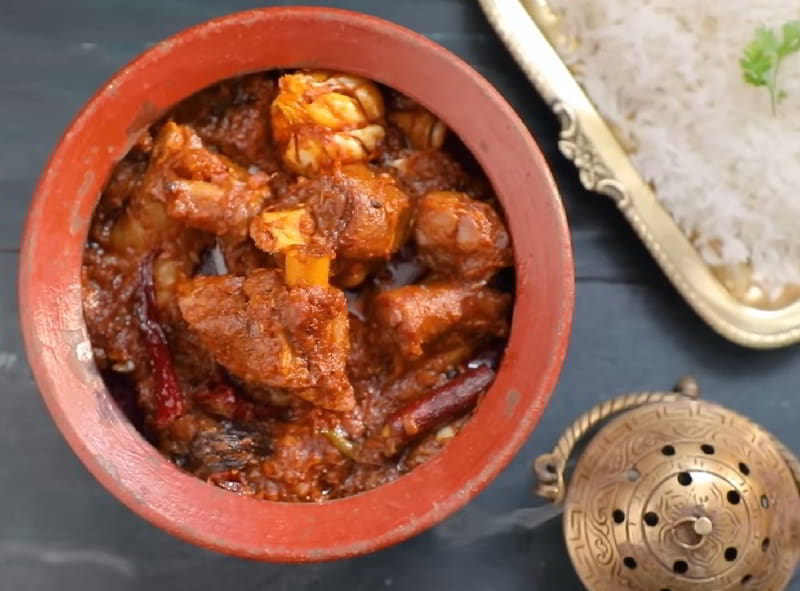
Champaran meat, also recognized as ahuna, batlohi, or handi meat, traces its roots to the culinary tapestry of Bihar, specifically the district of Champaran. This savory delight involves a meticulous preparation process, where succulent meat undergoes a flavorful marinade consisting of garlic, onions, mustard oil, ghee, and ginger, harmoniously blended with an array of spices. The marinated meat is carefully encased within an earthenware pot, its mouth sealed with kneaded flour. Slow-cooked over a low flame fueled by a wood fire, the handi is gently tossed throughout the process, ensuring a symphony of flavors. The exquisite taste and cooking duration are intricately linked to the quality of the meat. \
Champaran Mutton has transcended its regional origins, gaining widespread popularity in diverse metropolises such as Delhi, Mumbai, Kolkata, and Bangalore. This widespread recognition not only underscores its broad acceptance but also reflects the culinary finesse and appeal that this Bihari dish has acquired among discerning food enthusiasts across the country.
Ghugni
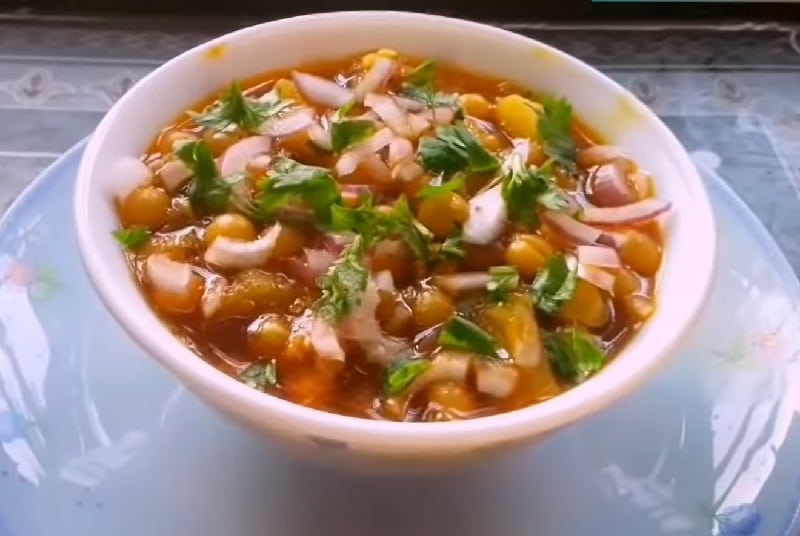
Ghugni, also known as guguni, is a delectable curry crafted from peas or chickpeas, offering various renditions utilizing distinct types of legumes like green peas, white peas, or black gram. This savory snack holds roots in the Indian subcontinent, particularly celebrated in the states of Bihar, West Bengal, Jharkhand, Odisha, Northeast India, and Bangladesh. In Bihar, the dish embraces the freshness of green chickpeas or newly harvested green peas. These legumes are gently pan-fried in mustard oil, complemented by green chilies and cumin seeds, setting it apart from the eastern Indian versions where a curry base is more common.
Ghugni showcases regional diversity with its unique variations, and its popularity extends to various cultural festivities, making it a cherished dish that reflects the rich culinary heritage of the region.
Tilkut
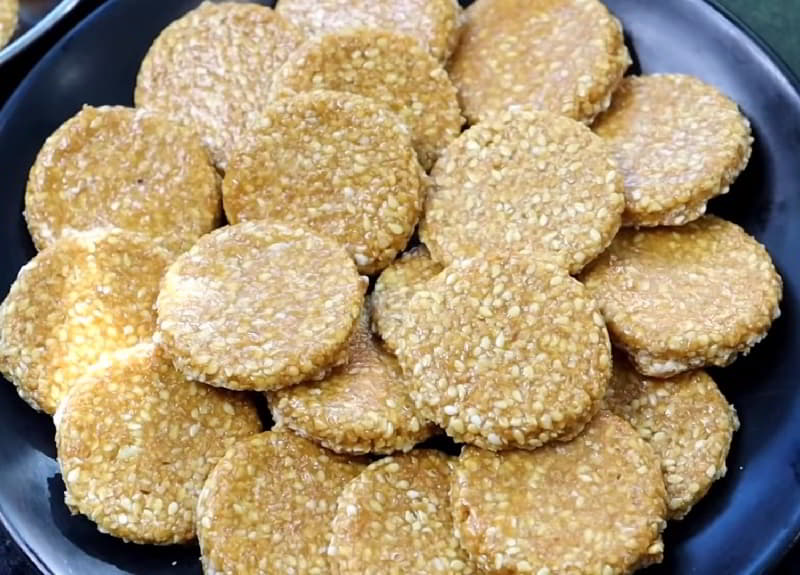
Tilkut, also referred to as tilkutam, gajak, or tilpatti, stands as a beloved sweet deeply embedded in the culinary heritage of Bihar and Jharkhand, showcasing a rich tapestry of flavors and traditions. This delightful confection takes center stage during the Sakraat or "Makar Sankranti" festival, showcasing its significance in the festive celebrations. Tilkut is meticulously crafted from pounded sesame seeds (Sesamum indicum) and jaggery or sugar, reflecting the agricultural abundance during the winter harvest, especially in regions like Gaya in Magadh. Buddhist literature refers to this sweet as palala, adding historical depth to its legacy.
Tilkut comes in three distinct varieties, each offering a unique flavor profile. The refined sugar tilkut, with its pristine white hue, contrasts with the light brown shakkar tilkut made from unrefined sugar, while the dark brown gur tilkut boasts the rich taste of jaggery. The circular savories are known as tilkut, while the smaller nut-sized counterparts go by the name tillouri.
As sugarcane harvesting peaks in winter, the production of tilkut becomes a communal affair, with towns and villages bustling with activity. While the demand persists throughout the year, the sweet's preparation remains a seasonal tradition, adding a touch of sweetness to various cultural celebrations.
Handia (drink)
-1706005692.jpg)
Handia, a traditional rice beer with roots in the Indian subcontinent, has gained popularity in states such as Bihar, Jharkhand, Assam, Madhya Pradesh, Chhattisgarh, Odisha, and West Bengal. The name Handia is derived from the Hindi word "Handi," representing the earthen pot traditionally used for its preparation. The process involves the utilization of ranu tablets, a blend of approximately 20-25 herbs serving as a fermentor. This unique concoction is mixed with boiled rice and left to ferment in earthen pots. The resulting drink, ready within about a week, is served cool, boasting a lower alcoholic strength compared to other Indian country liquors.
Initially reserved for special occasions like marriages and feasts, Handia has transitioned into commercial markets due to economic considerations, with daily sales becoming more commonplace.
Tarkari

Tarkari, an aromatic and flavorsome Indian curry, is celebrated for its diverse and robust taste. Originating from the Indian subcontinent, this vegetarian dish is a medley of vegetables immersed in a luscious and spicy gravy. The foundation of Tarkari consists of a sautéed blend of golden onions, tomatoes, ginger, and garlic, creating a fragrant base. A distinctive spice blend, featuring cumin, coriander, turmeric, and garam masala, contributes to the curry's intricate and well-balanced flavor.
The vegetable selection in Tarkari varies with the season and preferences, commonly including potatoes, cauliflower, peas, carrots, bell peppers, and eggplant. These vegetables absorb the spices' richness, resulting in a tender and satisfying texture. Tarkari pairs harmoniously with steamed rice or Indian flatbreads like roti or naan.
Versatile and customizable, Tarkari can cater to individual tastes, ranging from mild to spicy. Beyond its delectable taste, Tarkari is a nutritious choice, providing a wealth of vitamins, minerals, and fiber from its diverse vegetable array. Whether served as a main course or side dish, Tarkari elevates the culinary experience, embodying the essence of wholesome Indian cuisine.
Manda Roti (Rumali Roti)
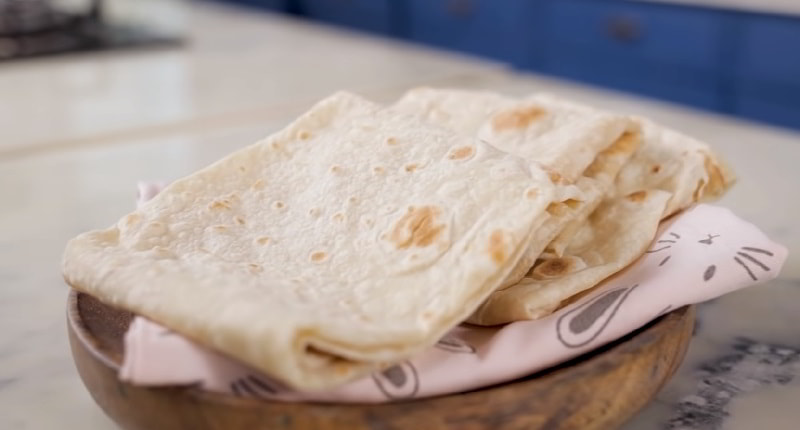
Manda Roti, also referred to as Rumali Roti, stands as a venerable creation in traditional Indian culinary history, with mentions in religious Sanskrit literature such as the purāṇas and ayurvedic and pākakalā texts like Nighantus and Bhojanakutūhala. This delicate roti is exceptionally thin and pliable, often served folded resembling a handkerchief. Crafted from a blend of white wheaten maida flour and whole wheat atta flour, Manda Roti is expertly cooked on the convex side of a kadahi.
This roti showcases the culinary diversity within the Indian subcontinent. Its thin and limp texture, coupled with the unique folding presentation, adds to the charm of Manda Roti. With a rich historical background and a distinctive preparation method, this roti is not only a culinary delight but also a cultural emblem that has stood the test of time.
Bhurta
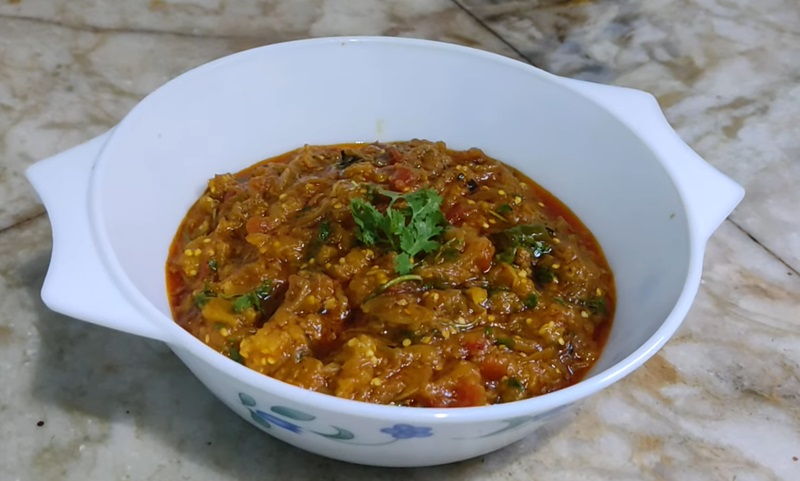
Bhurta, also known as bharta, bhorta, chokha, or vorta, is a delectable creation in the cuisine of the Indian subcontinent. This dish involves a lightly fried amalgamation of mashed vegetables, known as chakata. Varieties such as Aloo Bhurta and Baingan Bhurta showcase the versatility of this flavorful preparation. The term "Bhurta" has its roots in Sanskrit, signifying a dish that involves roasting or frying vegetables before mashing them into a spicy blend. The process may include roasting, boiling, or frying vegetables to achieve the desired texture and taste. Bhurta, with its aromatic and savory profile, stands as a beloved element in Indian culinary traditions, offering a delightful medley of flavors through its expertly spiced and mashed vegetable concoctions.
Kadhi Bari
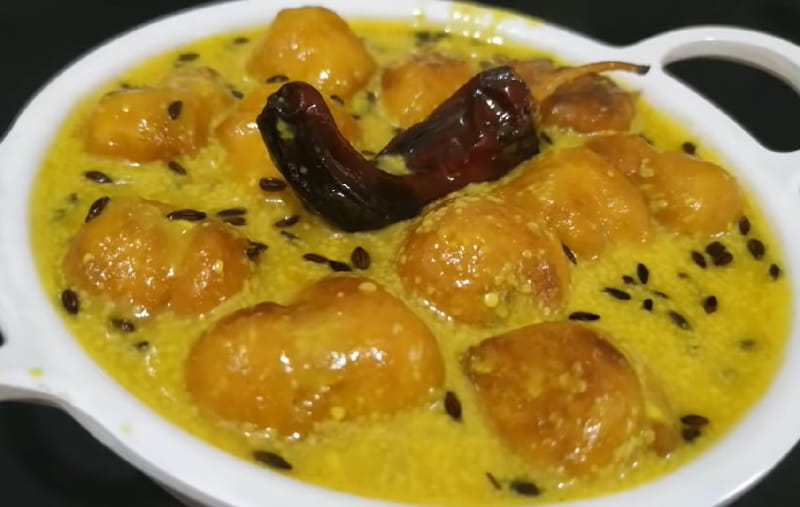
Kadhi bari, a South Asian vegetarian curry, is a beloved dish in the states of Uttarakhand, Bihar, Jharkhand, and Uttar Pradesh in India. This delectable curry combines gram flour (besan), yogurt (dahi), and an array of spices. The highlight of the dish is the bari, dumplings crafted from besan paste, which are deep-fried to perfection in cooking oil. The kadhi itself is prepared by blending yogurt, gram flour, and spices. This flavorful vegetarian delicacy is especially relished during the summer months and festive occasions like Jur Sheetal, Krishna Janmashtami, and Holi. While it is commonly served with steamed rice, it can also be enjoyed with roti or puri.
Kadhi bari encapsulates the essence of regional Indian cuisine, offering a delightful combination of textures and flavors that make it a staple in the culinary traditions of these northern states.
Tarua
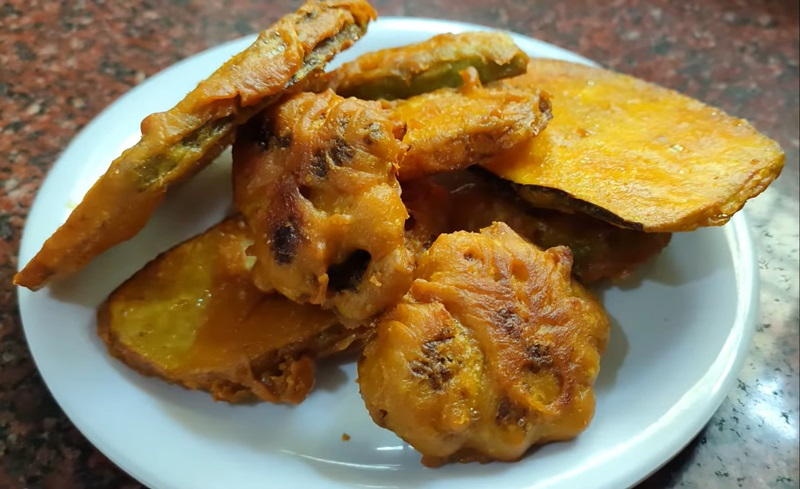
Tarua, a cherished dish originating from South Asia, holds a special place among the Maithils of India and Nepal, particularly in the Mithila region. Revered as a symbol of hospitality, it is believed that welcoming a guest without serving Tarua is incomplete.
This delectable dish features thinly sliced vegetables, including various green vegetables and vegetable leaves, coated with a flavorful batter made from gram flour or rice flour. The batter is seasoned with red chili powder, black pepper, and salt, creating a harmonious blend of spices. The vegetable slices, enveloped in this seasoned batter, are then lovingly deep-fried to perfection in oil. Tarua stands as a culinary delight, embodying the warm hospitality and culinary traditions of the Mithila region, where every bite is a celebration of flavors and cultural richness.
Gulab Jamun
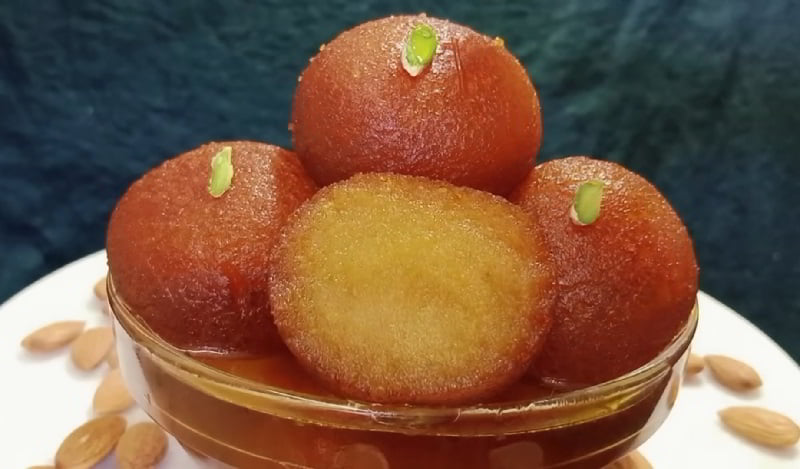
Gulab Jamun, a cherished dessert, holds a significant place in cultural and festive celebrations. Traditionally crafted from khoya, milk reduced to a soft dough, modern versions incorporate dried or powdered milk. This iconic sweet, adorned with dried nuts, undergoes a meticulous process. Milk solids, derived by simmering milk, are kneaded with flour, shaped into small balls, and deep-fried before being soaked in a fragrant sugar syrup. The resulting delicacy, infused with cardamom and rose water, is a delectable treat.
Gulab Jamun pairs exquisitely with vanilla ice cream or kulfi, making it a favorite at festivals, birthdays, and special occasions like Eid ul-Fitr, Eid al-Adha, Diwali, and Ganesh Chaturthi. With diverse variations, Gulab Jamun remains a symbol of sweetness and joy in cultural festivities.
Roti (Chapati)
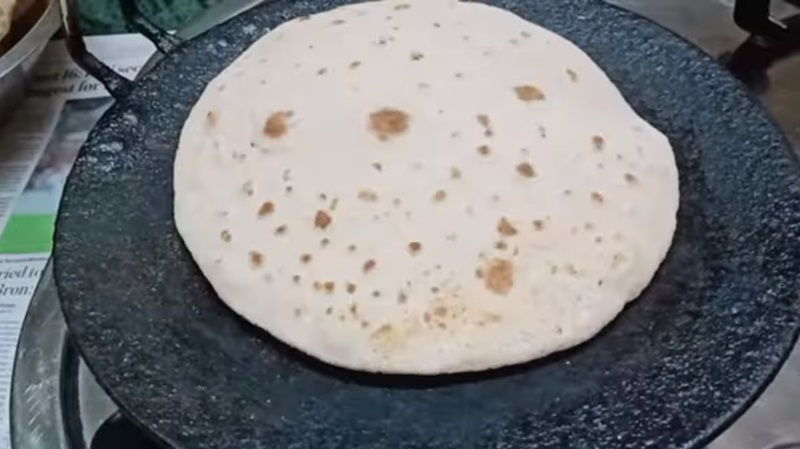
Roti or Chapati, a culinary cornerstone not confined to Bihari cuisine but ingrained in the wider Indian subcontinent, stands as a humble yet delightful flatbread created from whole wheat flour. This versatile creation serves as an ideal canvas for diverse accompaniments or transforms into a hearty wrap for curries and vegetables. The preparation involves blending whole wheat flour with water and a pinch of salt, resulting in a soft and pliable dough. Rolled into thin discs, these portions are cooked on a hot griddle until the Roti puffs up and develops golden brown spots, delivering a tender, chewy bread with a subtle crispiness. Often presented hot with ghee or butter, Roti undergoes an elevation in flavor and richness.
Whether partnered with curries, lentils, or relished alongside vegetables and pickles, Roti transcends its role as a mere food item. It encapsulates cultural warmth, comfort, and communal unity, becoming a beloved and nourishing dish embraced by individuals of all ages.
Chaat
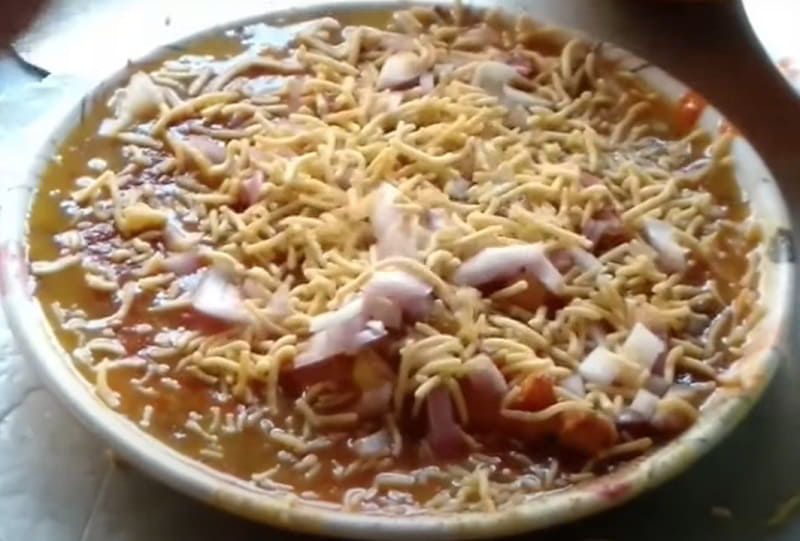
Chaat, a cherished culinary genre in India, unfolds as a tantalizing medley of flavors and textures, enticing taste buds from street corners to dining tables. Rooted in a base of fried dough, its variations showcase an array of complementary ingredients that make each bite a sensorial delight. The classic chaat, a blend of potato pieces, chickpeas, spices, and crispy fried bread, forms the heart of this savory family. From alu tikkis to dahi puri, each variant introduces diverse elements like onions, peas, coriander, and a hint of yogurt. Toppings of sev, chopped onions, and a sprinkle of chaat masala, a blend of spices like dried mango powder, black salt, and cumin, elevate the experience.
The spectrum of flavors, ranging from tangy and spicy to refreshing, captures the essence of Indian culinary ingenuity, making chaat a beloved and universal indulgence. Whether relished as appetizers or from bustling food carts, Indian Chaat embodies the rich and diverse tapestry of flavors that define the country's culinary landscape.
Paratha
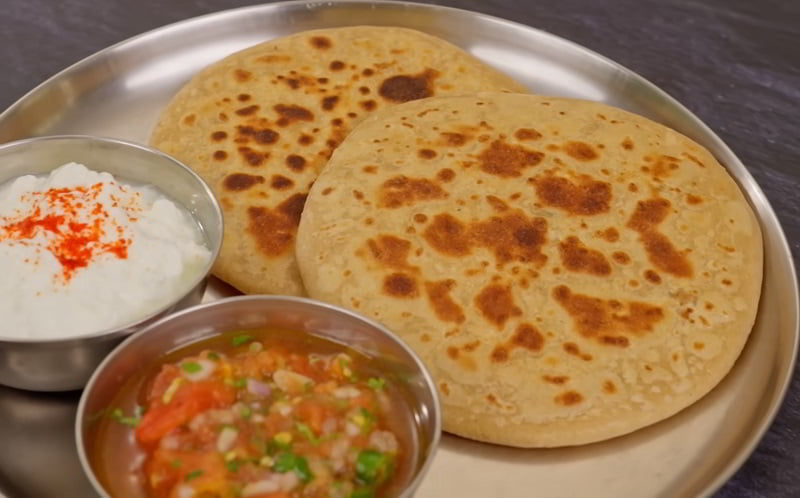
In the tapestry of Indian cuisine, Paratha emerges as a culinary jewel, celebrated for its rich flavors and diverse iterations across the subcontinent. The term "Paratha," derived from "parat" and "atta," alludes to layers of cooked dough. This flatbread is meticulously crafted by cooking whole-wheat (atta) dough on a tava, culminating in a shallow-frying technique that imparts a flaky consistency. While plain parathas exhibit thickness and heartiness, their stuffed counterparts offer an array of delightful options. The inclusion of spiced mashed potatoes (aloo paratha), cauliflower (gobi paratha), minced lamb (keema paratha), or dal enriches the spectrum of flavors and textures.
Much like the lamination of puff pastry, the layers in Paratha contribute to its uniquely flaky texture. These delectable flatbreads are often paired with white butter and complemented by an array of accompaniments, including fried eggs, curd, mutton kheema, omelette, nihari, daal, jeera aloo, or raita. As a satisfying breakfast ensemble, Paratha's versatility and myriad stuffing possibilities showcase the culinary creativity inherent in Indian cuisine, promising a delightful and flavorful experience for those fortunate enough to savor its layers of goodness.
Raita
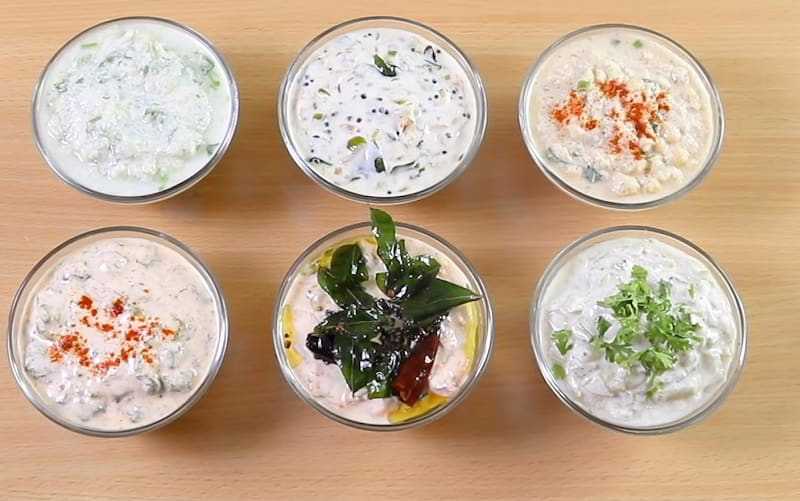
Raita, a yogurt-based delicacy, enjoys widespread popularity throughout India. This yogurt-based side dish features a harmonious blend of dahi (yogurt) with an array of raw or cooked vegetables, occasional fruits, or, as exemplified by boondi raita, crispy droplets of besan batter. Serving as a counterpart to the spiciness of curries and kebabs in Asian cuisines, Raita, unlike Western condiments, imparts a cooling effect. Often enjoyed alongside flatbreads, chutneys, and pickles, Raita exhibits versatility in its preparation, offering a refreshing contrast to various main dishes.
Raitas can be categorized based on three primary ingredients: vegetables, pulses, and fruits, each combined with yogurt and seasoned with a medley of spices. Following are various types of raitas -
1. Vegetable Raitas
- Brinjal Raita
- Carrot Raita
- Cucumber Raita
- Beetroot Raita
- Chili Salt Raita
- Onion Coriander Spring Onion Raita
- Horned Melon Raita
- Mint and Peanut Raita
- Onion Tomato Raita
- Spinach Raita
- Garlic Mint Raita
- Potato Raita
- Pumpkin Raita
2. Fruit Raitas
- Mango Raita
- Guava Raita
- Banana Raita
- Grape Raita
- Pomegranate Raita
- Pear Raita
- Pineapple Raita
3. Pulse Raitas
- Sprouted Green Gram Raita
- Bhujia Sev Raita
- Boondi Raita
These diverse raitas showcase the culinary versatility of Indian cuisine, offering a delightful array of flavors to complement various dishes.
Saag
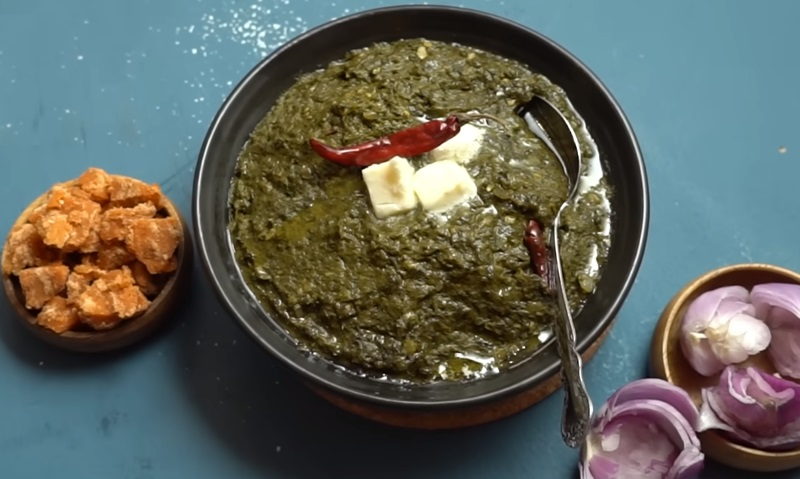
Saag, a revered dish in the Indian subcontinent, is a leafy vegetable preparation typically enjoyed with bread like roti or naan, or, in some regions, with rice. The versatile saag can be crafted from a variety of greens, including mustard greens, spinach, basella, collard greens, finely chopped broccoli, or other leafy vegetables. The greens are complemented with an array of spices and occasionally ingredients like chhena, enhancing the overall flavor profile.
In the Indian state of Odisha, saag holds particular significance, often paired with the traditional pakhala. At the revered Shree Jagannath Temple in Puri, saag is included in Mahaprasad, the sacred offering to Jagannath. The culinary tradition extends to West Bengal and North India, where sarson ka saag, made from mustard plant leaves, is a popular choice. This variant is often savored with makki ki roti, a maize flour-based yellow bread. Additionally, in the North Indian state of Punjab, saag gosht or hariyali maans, a delightful combination of spinach and mutton, enjoys widespread popularity, adding to the diverse tapestry of Indian cuisine.
Kheer
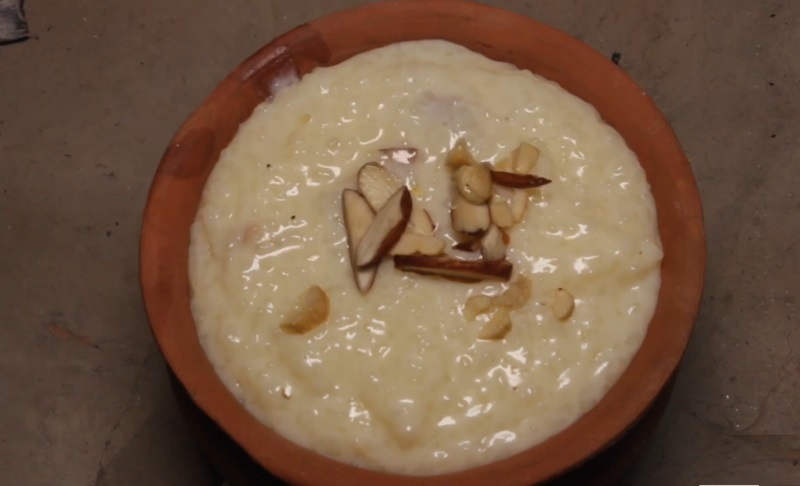
Kheer, also referred to as payasam or payesh, is a beloved pudding/porridge celebrated across the Indian subcontinent. The delectable concoction is crafted by simmering a blend of milk, sugar or jaggery, and rice to perfection. Beyond its core ingredients, kheer is enriched with a delightful medley of flavors, incorporating dried fruits, nuts, aromatic cardamom, and the subtle essence of saffron. This sweet delicacy offers a versatile canvas for culinary creativity, allowing for variations that feature cracked wheat, vermicelli (sevai), or tapioca (sabudana) in lieu of traditional rice.
Kheer is not merely a dessert; it encapsulates the essence of celebratory meals, finding its place at festive occasions, family gatherings, and religious festivities. The richness and comforting warmth of kheer have cemented its status as a timeless treat that transcends regional boundaries, bringing joy to those who savor its creamy, sweet goodness.
Aloo Gobi
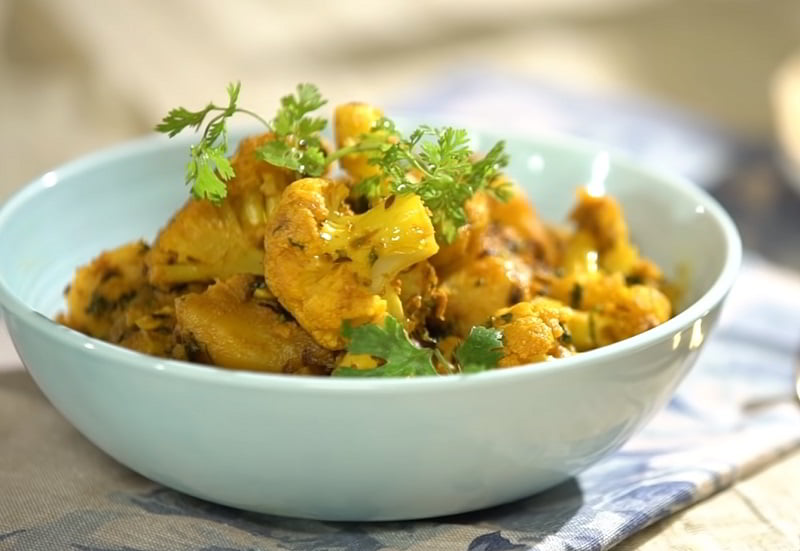
Aloo Gobi, a cherished vegetarian dish originating from the Indian subcontinent, showcases a harmonious blend of potatoes (aloo), cauliflower (gobhi), and an array of aromatic Indian spices. Renowned for its vibrant yellow hue, derived from the use of turmeric, this dish often features the subtle warmth of black cumin and the fragrant essence of curry leaves. Complemented by a medley of ingredients like onions, garlic, coriander stalks, ginger, peas, tomatoes, asafoetida, black pepper, and cumin, Aloo Gobi is a flavorful masterpiece.
Hailing from Northern India, this dish has transcended regional borders and gained popularity across the entire subcontinent, resonating in the cuisines of Nepal, Bengal, and Pakistan. Aloo Gobi's widespread acclaim is attributed to its comforting and hearty nature, making it a staple in households and a symbol of the diverse and rich tapestry of Indian cuisine. The versatility of this dish allows for numerous variations, each presenting a unique twist on the classic recipe, while preserving the essence of its cultural roots.
Aloo Paratha
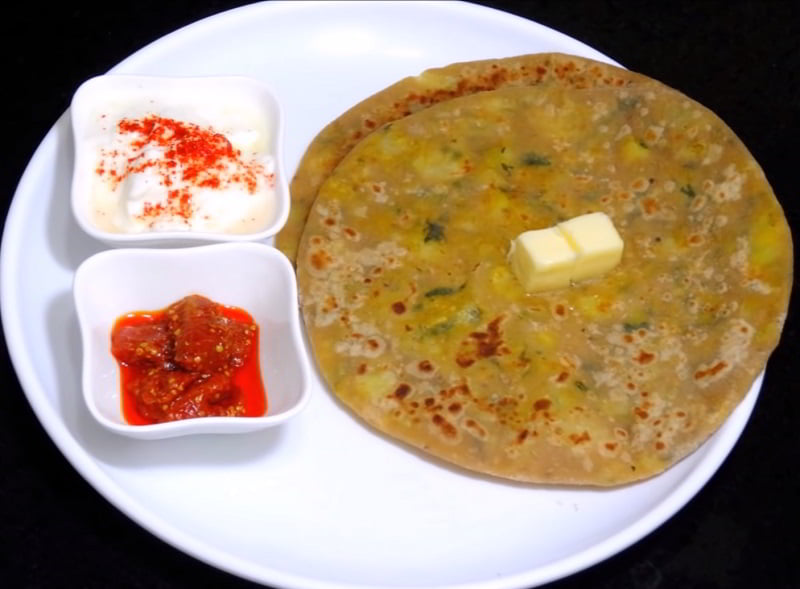
Aloo Paratha, a beloved flatbread dish originating from the Indian subcontinent, is a quintessential breakfast delight. Crafted from unleavened dough, this paratha is distinguished by its stuffing, which consists of a delectable mixture of mashed potatoes infused with aromatic spices such as garam masala and amchur (dried mango powder). The preparation involves rolling out the dough, enveloping the flavorful potato filling, and then cooking it on a hot tawa with a generous touch of butter or ghee.
The symphony of flavors in Aloo Paratha makes it a gastronomic delight, and it is often served with accompaniments like butter, curd, chutney, or a selection of Indian pickles. This wholesome and savory breakfast option not only provides a fulfilling start to the day but also pays homage to the rich culinary traditions of the Indian subcontinent, where each bite is a celebration of the region's diverse and aromatic spices.






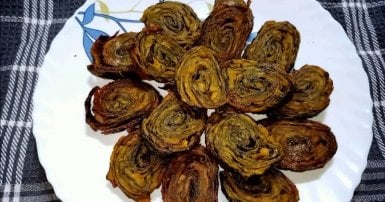
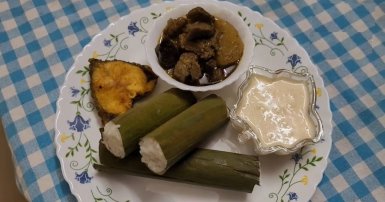
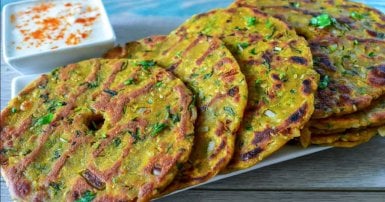
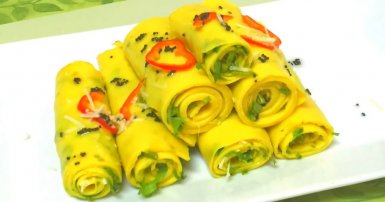
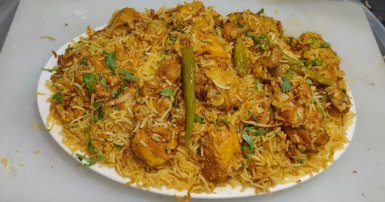
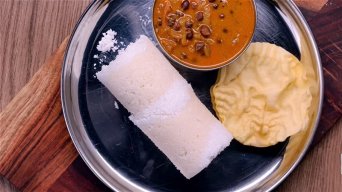

-1709813013.jpg)


